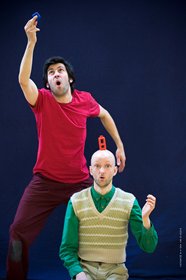A clash of personalities has been at the centre of the work of a number of playwrights - but rarely has it been as much fun as Branar's Spraoi. Billed as being for children aged 3-6, it will thrill audiences several decades older with its outstanding performances and sense of play. Laugh out loud funny but also genuinely affecting, it captures the comic confusion that abounds as children try to communicate, free from the interference of their elders, when the unifying bond of language is removed.
Two boys meet. One is Irish. One is from Catalunya. One speaks Gaeilge. The other Catalan. One is forward, the other shy. While one is messy, the other is neat. Together they must overcome their differences to have the craic, to share their lunch and toys without upturning each other's world.
Simple character work and effective costuming sets the scene, with Jonathan Gunning and Miquel Barceló convincing from the off as babies who have had little social interaction with children of the same age. The scars of the latter's enthusiasm are marked on his clothes, patched and unruly, his wide-eyed and overzealous manner startling the former, who is well turned out in his shirt and cardigan vest. Barceló is almost writhing with excitement at the possibility of a playdate; Gunning would rather shake hands than hug – and as the tension, frustration and anticipation is built up between the two ‘boys’, their facial expressions and sudden, unexpected movements bring the house down.
This is an incredibly well observed and detailed piece of theatre, whose success at connecting with its audience is seen not just in the children, who were actually screaming for joy at what they were relating to, but in the adults who accompanied them, as memories of that time come flooding back: the refusal to share only softened by the realisation that the other had something you wanted; the opening of your eyes by another's imagination; the unrestrained curiosity in the actions or appearance of another. It's all captured in the performances of the players who not only revert to their playing age but also bring you with them. The wary introductions, the awkward interactions, the sudden joyous rushes and the precarious mood swings when things turn out differently to what one expected: Director Marc Mac Lochlainn has developed a piece that captures all the emotions of that time of life.
 The smoothness to all these transitions is a testament to Branar's development process where they spend up to a year developing and testing their work before they bring it out on the road. The intentions of the performers are crystal, there is no need to play up to the audience. They don’t cheapen their show by dumbing themselves down or oversimplifying. Their trust in the comedy of what they are doing is shown in their ability to let it come out naturally, not signpost the chuckles.
The smoothness to all these transitions is a testament to Branar's development process where they spend up to a year developing and testing their work before they bring it out on the road. The intentions of the performers are crystal, there is no need to play up to the audience. They don’t cheapen their show by dumbing themselves down or oversimplifying. Their trust in the comedy of what they are doing is shown in their ability to let it come out naturally, not signpost the chuckles.
Branar are best known for using puppets to express what they call “the language of no language”, where words are only one element used to tell a story. Here aspects of clowning are used to make the predominantly English speaking audience understand what is going on in this bi-lingual show, using our lack of fluency as a boon rather than a bane, so that we are as complicit in the struggle the boys have in comprehending one another.
No joke is made of the fact that it is two actors in their 30s playing the children as, so totally have they convinced us of the fact, it would shatter the illusion. And the roared suggestions of the crowd prove that the children were able to focus on the problem at hand, rather than the manner in which it was presented. This is top class theatre for any age: Don't miss it.
Caomhan Keane is a freelance journalist who has written about theatre for The Irish Times and the Sunday Independent and is senior theatre writer at entertainment.ie